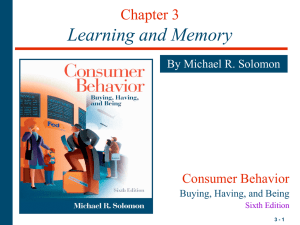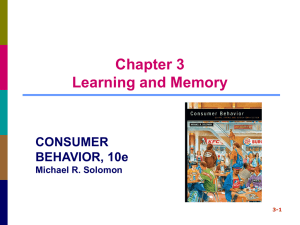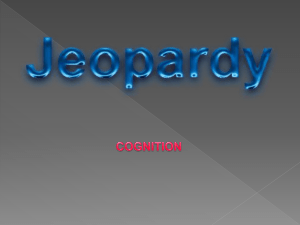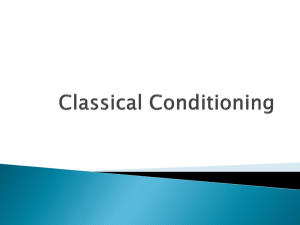lmi-ipm(2)
advertisement
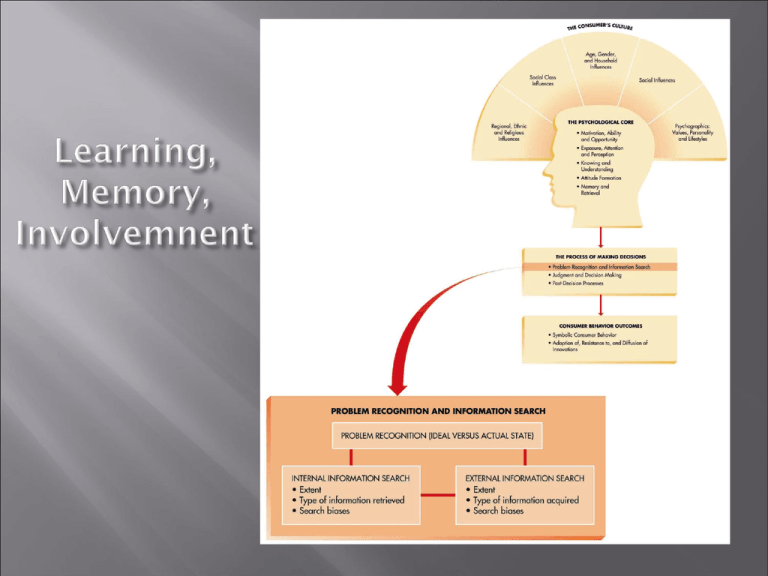
Low involvement Choice Usage High involvement Utilitarian Ego-expressive (practical) (ultimate choicest) A B C Version A Version B Version C Learning is a relatively permanent change in behavior caused by experience Experience need not be direct and can be by observing events that affect others We learn even when we are not trying Intentional learning (careful search for info) Vs. Incidental learning (causal, unintentional acquisition of knowledge) Classical Conditioning (McDonalds, repetitions-pepsi slogan ‘yeh dil mange more’ with different slogans, fevi kwik ‘chutki mein chipke’ for Learning Curve, stimulus generalizationstrategy for positoning to families like brands of lakme, phillips, sony, bajaj, stimulus discrimination by the innovators and leaders like maggi tomato chilli sauce saying slogan ‘it’s different’, OC detergents, coldarin, pain relivers, shampoos , deodorants showing reward after embarrasement. Consumer learning … the process by which individuals acquire the purchase and consumption knowledge and experience that they apply to future related behaviour (Schiffman and Kanuk, 2000) In order for learning to occur, certain basic elements must be present Motivation, cues, response and reinforcement Motivation Cues …a weak stimulus, not strong enough to arouse consumers, but capable of providing direction to motivated activity Shopping environment is packed with cues, such as in-store promos, displays Response ‘Cos motivation arouses individuals, thereby increasing their readiness to respond Prickly heat powder commercials during summer … consumer’s mental or physical activity in reaction to a stimulus situation On-line shopping instructions – ‘How to’; 30-day free trial; samplers Reinforcement …anything that follows a response and increases the tendency for the response to reoccur in a similar situation Using the express counter at Food-World/Counter once Classical conditioning … when a stimulus that elicits a response is paired with another stimulus that initially does not elicit a response on its own. Over time, this second stimulus causes a similar response because it is associated with the first stimulus Ivan Pavlov’s experiments with Dogs Pepsi using Britney and ‘We’ll rock you’ in its commercials Oral-B toothbrushes with an ‘early warning system’ for timely replacement Instrumental (or operant) conditioning … occurs as the learner learns to perform behaviors that produce positive outcomes and to avoid those that yield negative outcomes Positive reinforcement (e.g. ads saying ‘get a beautiful skin’) Negative reinforcement (e.g. ads saying ‘get rid of dry skin’) Punishment (e.g. ads describing the consequences of not acting now; e.g. Alcohol Ads, fear appeals like the bugler alarms, life insurance) Extinction (e.g. the consumer is no longer satisfied and marketer must act; reduce advertizing for some reasons e.g. promise toothpaste) Unconditioned stimulus (UCS)-FOOD Unconditioned Response (UCR)SALIVATION Conditioned stimulus (CS)-BELL AFTER REPEATED PAIRINGS: Conditioned stimulus (CS)-BELL Conditioned Response (CR)SALIVATION Forward conditioning Backward conditioning CS preceeds US (i.e., product before the celebrity) US preceeds CS (i.e., celebrity before the product) Simultaneous conditioning Both to be presented at the same time THINK about the media choice for these variations! An example: Unconditioned stimulus – Microsoft brand symbol, the Windows icon Unconditioned response – the Windows icon that implies technological superiority and trouble-free operation Conditioned stimuli – New MS Office-XP bearing the well-known Windows icon symbol Conditioned response – MS Office-XP embodies technological superiority and trouble-free operation Repetition Repeated exposures increase the strength of S-R associations and prevent the decay of these associations in the memory (forgetting) Slogans, Logos … but beware of ad wear out and competitive advertising Cosmetic variation – same theme, different formats Substantive variation – same cosmetics, different content Stimulus Generalization Refers to the tendency of stimuli similar to CS to evoke similar, conditioned responses Explains the success of ‘me-too’ products and private label brands (that make their packaging resemble the Leader) Other marketing applications – product-line extension (Pepsi Lemon), product-form extension (Pepsi can), product-category extension (Aquafina), Family branding (Nestle’s Maggi, HP), Licensing (Tommy, CK, Disney), usage situation generalization (French Oil) Stimulus Discrimination Occurs when a stimulus similar to a CS is not followed by a UCS. When this happens, reactions are weakened and will soon disappear. Imitators want consumers to generalize their perceptions but market leaders want to retain the top spot by convincing consumers to discriminate (by effective positioning – establishing a unique image for a brand in the consumer’s mind) Product line extension – Tylenol (J&J) makings its products available in a number of forms (tablets, capsules, gelcaps), strengths (regular, extra-strength and children’s) and package sizes Product form extension – Ivory bath soap to Ivory liquid soap to Ivory shower gel Product category extension – disposable BIC pens to disposable BIC razors Family branding – Campbell’s Soup company adding new food products to its product line under the Campbell’s brand name; Ralph Lauren designer label on men’s and women’s clothing Licensing – Tommy Hilfiger, Calvin Klein on caps, clothing, luggage, toys, …. (with the risk of counterfeiting!) Product differentiation – ‘teaching’ the consumers (thru advertising and selling) to associate the brand name with a specific product Learning based on mental (problem-solving) activity Emphasis is NOT on WHAT (say, repetition or association of a reward with a specific response) is learned, but on HOW (i.e. information processing) it is learned Observational Learning Also called as Social learning or vicarious learning or modeling Application: Testimonial ads, Involvement Theory Based on hemispherical lateralization or Split-brain theory Left-hemisphere is primarily responsible for cognitive activities (reading, speaking, attribution information processing) – it’s rational, active and realistic Right-hemisphere is concerned with nonverbal, timeless, pictorial and holistic information – it’s emotional, metaphoric, impulsive and intuitive Impact on Media strategy – TV viewing is considered a rightbrain activity (passive learning thru low-involvement info processing) and Print media and interactive media are considered high-involvement media. Components of observational learning Memory is availability and Retrieval is accessibility Memory affects the exposure, attention, and comprehension stages How consumers store, retain and retrieve information Memory allows consumers to anticipate the stimuli they might encounter External Inputs Encoding Information is Placed in Memory Storage Information is Retained in Memory Retrieval Information Stored in Memory is Found as Needed … are the methods of handling information which may operate consciously or unconsciously to influence the encoding, placement, and retrieval of information. Encoding … the process by which we select a word or visual image to represent a perceived object Examples: Kellogg’s, Asian paints Retrieval cues create a response by actively reconstructing the stimulus Response generation is when a person develops a response by actively reconstructing the stimulus. Rehearsal … silent, mental repetition of information; failure to rehearse an input, either by repeating it or by relating it to other data, can result in fading and eventual loss of the information An associative network for perfumes Research finding It is difficult for consumers to remember product information from ads for new brands in heavily advertised categories Consumers can become cognitively overloaded when they are given a lot of information in a limited time Interference: the greater the number of competitive ads in a product category, the lower the recall of brand claims in a specific ad Example: when consumers attributed the Eveready Energizer Bunny to the market leader, Duracell Inputs Sensory memory Short-term memory (working memory) Available capacity Affect and arousal Encoding Retrieval Long-term memory Sensory memory Iconic (regarding what we see) and echoic (regarding what we hear) memory Sensory memory happens in the pre-attention stage where a stimulus is briefly analyzed to determine if it will receive additional processing. E.g if we close our eyes we can remember the after image in our mind’s eye for just a fraction of second. Short-term memory (STM) (can be viewed as Conscious thought) Imagery and discursive (i.e. language) processing Short-term memory is where information is temporarily stored while people are actively processing it. Also called working memory. If information in short-term memory is not rehearsed it is lost within 30 seconds. E.g. a long number 91-0141-550053 can be grouped to generate a short term memory or there can be brand name and symbols for the same Involvement (split brain theory) and short-term memory High involvement makes the consumer more aroused and attentive, expanding the short-term memory capacity. Low involvement tends to keep a consumer’s arousal levels low so the consumer focuses relatively little memory capacity on the stimulus. Long-term memory (LTM) Long-term memory is connected to short-term memory through encoding and retrieval processes. Long-term memory has essentially unlimited capacity to store information permanently. Stored information is either semantic or visual Autobiographical (episodic) memory – represents knowledge we have about ourselves (In CB context, it refers to acquisition, consumption and disposition) Semantic (associative) memory – represents knowledge about the world that is detached from specific episodes. Examples: Schemas and categories with connecting links (called beliefs or associations) e.g frequent repeated advertizing i.e learning the information already stored in the memory. Sensory Memory Attention Short-Term Memory Elaborative Rehearsal Long-Term Memory Relationships among memory systems Chunking Marketing communication to serve as a chunk (group of items that can be processed as one unit) Example: Maruti, Rs.2599, other benefits Rehearsal Recirculation (continual repetition) Active and conscious interaction with the material to remember (say, repeating the help-line number, engaging jingles and slogans) Example: Energizer’s line – ‘it goes on and on and on’; engaging jingles and slogans (esp. when motivation is low) Similar to rehearsal, but does not involve active processing; because of repeated exposures Example: Where all do you see ‘Pepsi’ on a given day? Elaboration Processing information at deeper levels Interactive ads, Q&A type of ads Familiarity State-Dependent Retrieval Age Oldish Interference Retrieval Forgetting Salience Pictorial/Verbal Cues Newer Brands (many of them) Not enough Cues By characteristics of the stimulus By what the stimulus is linked to Priming, Retrieval of cues By the way in which the stimulus is processed Favourability, Salience, Prototypicality (graded categorization), Congruence (as per the expected attributes), redundancies (when brand is named, claims and visuals convey the same info) As pictures and words in memory The characteristics of the consumers Mood and expertise Consumers tend to remember the product’s benefits rather than its attributes Incongruent (or unexpected) elements pierce consumers’ perceptual screens and improve the memorability of an ad when these elements are relevant to the advertising message Example: ad for a brand of stain-resistant, easy-toclean carpet Incongruent elements that are not relevant to an ad also pierce the consumers’ perceptual screen but provide no memorability for the product Example: Glamour in advertising

